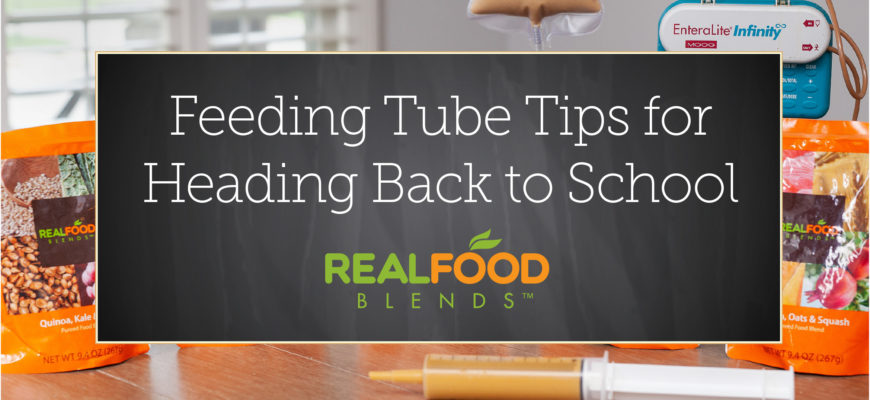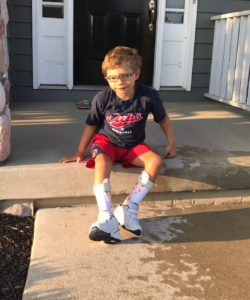
Feeding Tube Tips for Heading Back to School
The start of a new school year is an exciting time for all families, but sending your child with a feeding tube to school for the first time can be nerve-wracking for both parents and kids. That’s why we put together our tips for tube feeding at school, particularly when using our meals or a home blended diet. With a little preparation and organization, tube feeding at school doesn’t have to be that different from feeding at home.
Before School Starts
Most schools will require a doctor’s note or doctor instructions to feed your child during the school day. Including your child’s feeding plan in their IEP and 504 plans is also important. Offer to train the person who will be feeding your child at school, whether that is the school nurse, an aide, or someone else. Also make sure at least two people are trained to feed your child in case the main person is ever unavailable. The Feeding Tube Awareness Foundation has a free School Training Presentation designed to train school nurses, teachers, aides, and other school staff about tube feeding. Be specific about volume and feeding times in the feeding schedule you have on file with the school. If your child uses a pump, tell school staff how to deal with any pump alarms that might happen. Many schools will have a specific protocol for how they handle a feeding tube that comes out during the school day, so make sure you know your specific school’s policy, including if you can send an emergency kit to replace a feeding tube at school.

Preparing for the First Day
Ahead of your child’s first day of school, make sure you label everything you’re sending, from syringes to insulated bags to pump bags and backpacks (if used). If your child is using Real Food Blends meals, you can send them to school without an ice pack or cooler, but make sure the school is aware that any leftovers need to be refrigerated within 2 hours of opening the pouch. If the school allows you to send food ahead of time, you can send Real Food Blends meals one week at a time or more since they are shelf stable for 3 years from the date of manufacturing. If you bolus feed and are sending blends from home, or just want to save time during the school day, mom Kara recommends sending prefilled syringes. “I prefill syringes and cap them for the nurse daily. Then I put them in a one-gallon Ziplock bag with a primed extension. Makes it easier for the nurse and in turn a quicker experience for our son!” Just remember with this option, whether you’re using home blends or Real Food Blends, to send the pre-filled syringes in a cooler/insulated bag with ice packs and make sure the syringes are refrigerated at school until they are ready to be used.
Helping Your Student Adjust
While you may be nervous about sending your child to school for the first time with a feeding tube, remember that your child might be nervous, too! If this is your child’s first overall experience at school, they may have questions about their new schedule and who will be helping them throughout the day. Make sure to walk your child through their schedule and explain to them where they need to go for tube feedings and who will be helping them. Don’t be afraid to adjust your child’s feeding schedule during the school year, too. Being nervous about a new routine might mean your child won’t be able to take the same volume at school—consider making lunch smaller and incorporating a before or after lunch snack into their school feeding schedule or an after school snack at home. When possible, we always encourage those using Real Food Blends to use a mealtime schedule just like those who eat orally, which often includes a snack in addition to breakfast, lunch, and dinner. We’re just talking about food, after all!
If your child previously ate orally, they may be nervous about answering questions about their feeding tube at school and how lunchtime will be different. Giving a presentation to your child’s class about tube feeding at the beginning of the school year can be a great way to alleviate some of these worries for your child and make his or her classmates feel more at ease with feeding tubes. Feeding Raya has a great example of a presentation her kids gave to their classes about their younger sister with a feeding tube. For preschool or kindergarten classes, reading My Belly Has Two Buttons to the class is a great option as well.
If anyone at your child’s school has questions about Real Food Blends, our new RD Hub is a great resource or you’re welcome to direct them to call us at 888-484-9495. You can also reach out to us via our Facebook page. The Feeding Tube Awareness Foundation also has a wealth of general tube feeding information, especially for those new to tube feeding. From all of us at Real Food Blends, we wish you and your child a fantastic school year!






